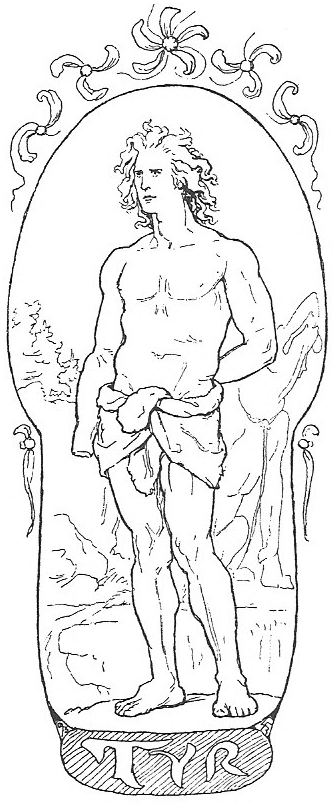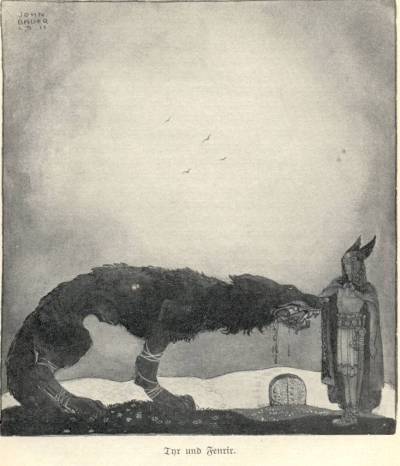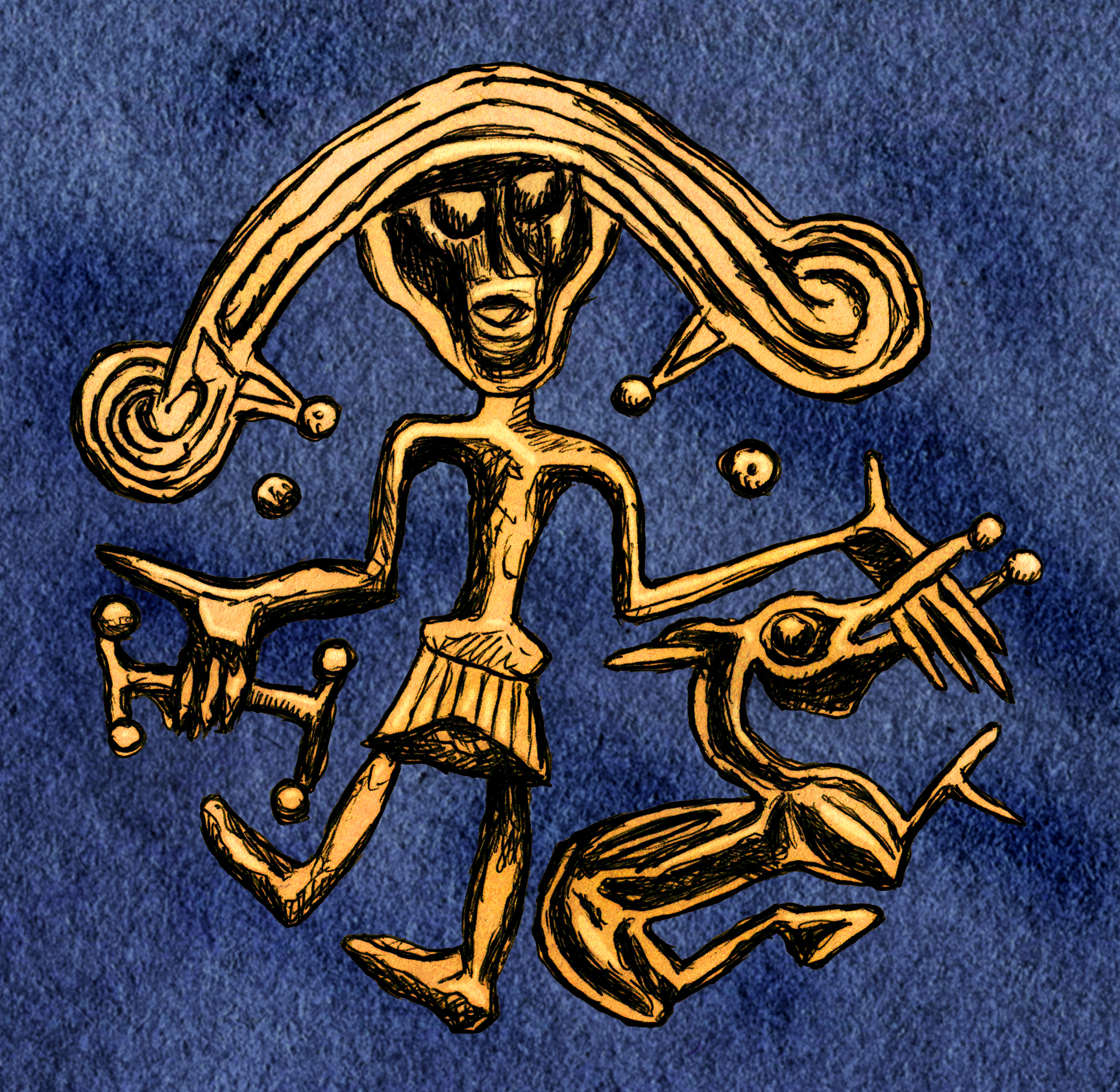Two weeks ago, I discussed the war gods Thor and Odin and how they contrasted with one another in their manifestation as gods of war. I also mentioned parenthetically another war god, Týr, who was not especially important to the Vikings but who was still part of the pre-Christian Germanic pantheon and carried out a war function as well.
This week, we’ll try to work out Týr’s place in that pantheon and what his role was in general, as a war god specifically, and how he differed from Thor and especially Odin, since Týr was not only a god of war, but also once seemed to be the chief god of all the Aesir.

Týr was once the chief of the Aesir, lord of all the gods of the Germanic pantheon. We know this more from hints and etymology than from stories, as the bulk of the stories we call “Norse mythology” were composed during the Viking Age and written down by Christian scholars in the centuries shortly following that period.
However, one attestation we have of Týr’s importance comes from the Roman scholar Tacitus, who studied the Germanic tribes the Romans encountered, and he compared Týr to the Roman god of war Mars, while Thor was compared to Hercules and Odin to Mercury; while you might wonder that none of these gods were associated with Jupiter or Apollo/Phoebus, note that Tacitus was describing how important the gods were and then using the interpretatio romana method of equating the Germanic gods with Roman gods to help the reader understand their function in cults and ceremonies. To Tacitus, Týr seemed outclassed in worship only by Odin and Thor. Interestingly, later attestations of the importance of Týr to the Germanic peoples seem to indicate a smaller role than is indicated by Tacitus, and Freyr is commonly treated as a occupying the place Týr did a thousand years earlier. I am not sure whether this is attributable to regional differences or the centuries-long wane of Týr’s religious significance (take this as yet another reminder that I am an amateur, not an expert).
But even though we know Týr was not the chief of the Aesir among the peoples Tacitus studied, our reasons for believing him to have such influence come from etymology and comparative religion. The name Týr derives from the Proto-Indo-European Dyeus, and somewhere between those ancient Proto-Indo-European cultures and the Germanic peoples who worshipped Týr was a god named Tiwaz. Dyeus is the word which eventually becomes the Greek Zeus, deus, and dei. It’s associated with the Indian deva and the Roman Jupiter (Dyeus Phater, “sky father”). It’s evolved into today’s English word “deity”, and in Old Norse, “týr” wasn’t just the name of the god Týr, it was the generic term for gods, as typified by one of the many pseudonyms for Odin, Hangatýr, “god of the hanged”. For centuries, it seems likely, Týr was the god, the one most important to the Germanic peoples.
No one’s really sure why that changed. There’s good reason to believe that some shakeups occurred at least once during the religious lives of the pre-Christian Germanic peoples because of the mythological evidence presented by the Aesir-Vanir war, a war between the tribe of gods including Odin and Thor and another tribe that included Freyr and Freyja. Týr is not mentioned in that story, but an event like it occurs in other pantheons, most notably the Indian/Hindu, and may indicate that one tribe migrated, bringing their gods with them, and some important features of regional religious practice changed to accommodate the emigration. This is just speculation though, and not merely on my part: even this theory derives from scholars sifting through comparative mythology.
But on to Týr himself: if Odin is the god of the hanged and shamanic fury and Thor the god of protection and blessing, what role did Týr have to play among the Vikings and their ancestors?
Týr is perhaps best-known as the one-handed god of war, justice, bravery, and promises kept. The best-known story of Týr’s honor and bravery is the tale of how he willingly offered his hand so that the giant wolf Fenris could be bound in shackles until the day that Ragnarök came. The story, from the Prose Edda tale Gylfaginning, is brief enough to quote in full here:
The Wolf said: ‘If ye bind me so that I shall not get free again, then ye will act in such a way that it will be late ere I receive help from you; I am unwilling that this band should be laid upon me. Yet rather than that ye should impugn my courage, let some one of you lay his hand in my mouth, for a pledge that this is done in good faith.’ Each of the Æsir looked at his neighbor, and none was willing to part with his hand, until Týr stretched out his right hand and laid it in the Wolf’s mouth. But when the Wolf lashed out, the fetter became hardened; and the more he struggled against it, the tighter the band was. Then all laughed except Týr: he lost his hand.

The fetters put on the fearsome Fenris wolf, called Gleipnir and made of invisible, impossible substances, were intended to never be broken. This story is another in a line that shows how pre-Christian Germanic culture accepted that life required compromise, sometimes even compromise in important and dearly-held values. As a god dedicated to justice and honor, Týr was among the most dedicated to keeping promises; and yet, he put his hand in the wolf’s mouth knowing that the promise of Fenris’ release would be broken. Perhaps the story shows an even higher dedication to justice in that Týr left his hand in the wolf’s mouth to be bitten off; by sacrificing his hand, Týr shows that in the service of a higher cause (keeping an impossibly powerful foe at bay), keeping the terms of the agreement take precedence over keeping the first part of the agreement, and is worth more than the hand of a god of war.
Another chapter of Gylfaginning points out that Týr is described as “most daring, and best in stoutness of heart, and he has much authority over victory in battle; it is good for men of valor to invoke him. It is a proverb, that he is Týr-valiant, who surpasses other men and does not waver. He is wise, so that it is also said, that he that is wisest is Týr-prudent.”
This description is somewhat perplexing, as Týr sounds rather substantially like Odin, a god of war associated with knowledge of the magic runes and seeker of knowledge about the fate of the gods. In fact, the similarity goes even further when we recall that Odin sacrificed an eye for the wisdom of the Well of Urð; if Týr sacrificed his hand to restrain Fenris, the monstrous wolf, son of Loki, swallower of the Sun at Ragnarök, he shares a long list of traits with Odin that we cannot ignore.
If Týr is wise and invoked in battle, what then, is the purpose in having two such gods, who perform such similar functions?
Recall from the discussion of Odin’s and Thor’s roles as war gods that Odin is the god of the elite, taking any action, even sacrificial, and even invoking dangerous magic, to win the battle, serve the needs of the elite, and hold off Ragnarök another day. Thor, in contrast, was a god of strength and protection, conservative in a way, invoked by the warrior class, the farmers and merchants and tradesmen brought in to battle when war was absolutely necessary.

As a chieftain of the gods, Týr was likely also associated with the kings, jarls, and other elites of pre-Christian Germanic society. However, Týr’s only relationship with magic is through the use of the rune that shares his name, the tiwaz rune that looks like an arrow pointing upward. It is invoked only as supplication for victory; there is no change of consciousness, no future-telling or skin-changing. Instead, as the quotation above describes, warriors of Týr are simply valorous, valiant men (and women) who seek victory in just cause. After all, as the incident with Fenris shows, Týr is a god who keeps promises (except in dire circumstances) and tries to maintain justice and order. He is a god who fights war not to dominate, but to reach lasting peace. Odin is more easily associated with leaders wanting to change the status quo and Thor with the people, fighting on their own behalf in defensive struggles. Týr is the god of leaders and warriors who are fighting justly, and hope to find peace in valiant struggle.
But whether Týr was invoked often or rarely is impossible to know at this late date; he is rarely mentioned in the extant stories passed down to today. We have evidence, as mentioned above, from Tacitus and Snorri’s Prose Edda, and he is also brought up as a companion of Thor’s during the trip that turned into an expedition to fish for Jörmungand the Midgard Serpent.
Why Týr was surpassed by Odin and, perhaps, Freyr, in the pantheon of Germanic gods is difficult to discern. It may well be that once Odin became ascendant it seemed unnecessary to have a third war god, or it may be that Týr was invoked frequently but few monuments or stories were made in his name. In any case, Týr is another facet of the pre-Christian Germanic peoples’ understanding of war, a further insight into their understanding of the complex moral situation facing us all, and another example of the value of sacrifice, even among the gods.

One-eyed Odin was swallowed by Fenrir. One-eyed Shukra was swallowed by Shiva.
One-handed Tyr lost his hands to Fenrir. One-handed Savitr lost his hand to Shiva.
🙂
LikeLiked by 1 person
[…] role as animating forces of the community. As it is, there’s already some confusion about how Odin and Tyr form two faces of the idea of justice; with Forseti involved in resolving disputes and most likely leading decision-making sessions, the […]
LikeLike